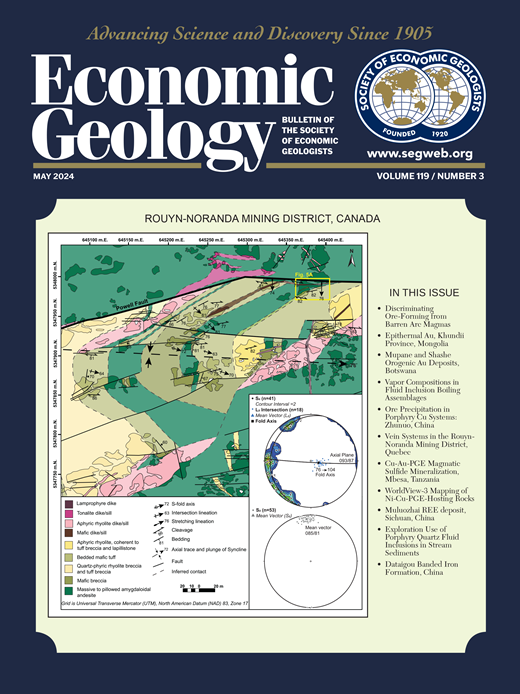阿根廷-智利Filo del Sol斑岩型Cu-Au和浅成热液型Cu-Au- ag成矿地质:安第斯隆起时期的极端伸缩
IF 4.9
1区 地球科学
Q1 GEOCHEMISTRY & GEOPHYSICS
引用次数: 0
摘要
Filo del Sol是一个复合斑岩-浅成热液矿床,位于南纬28°29′S,横跨阿根廷和智利之间的边界,由于几个超过1公里长的钻孔交叉点具有异常高的Cu、Au和Ag品位,最近引起了人们的广泛关注。该矿床位于新近确定的Vicuña成矿带中,该成矿带连接着著名的晚渐新世至中新世中期Maricunga和El Indio带。该成矿带长8.5 km,由N- ne向Filo del Sol斑岩和高硫化浅成热液中心组成。矿床赋存于二叠纪长英质火山岩中,受三叠纪二长花岗岩侵入,近地表为浅浸的晚白垩世火山沉积岩。这些岩性单元被几代基性岩脉和高级岩脉侵入,在中新世中期,被平行的闪长斑岩岩脉群侵入。矿间岩浆-热液角砾岩体与斑岩岩脉密切相关,随后在浅层被较小的、细粒的潜水成因角砾岩切割,也可能是潜水成因角砾岩。早期铜金成矿以黄铜矿为主,与含钾长石和黑云母的钾蚀变有关,并伴有a型石英脉入口网。钾质带被大量叠印,并被矿床核心的空洞残余石英和硅化区广泛重建,两侧是石英明矾石,作为更广泛的岩盖的一部分。这些蚀变类型含有高硫化铜-金-银矿化,如黄铁矿、早期辉石矿和晚期斑铜矿、辉铜矿、钴岩矿和大量含银亚硫酸盐,最高品位通常局限于孔洞残余石英中。大部分贫瘠的、蒸汽加热的蚀变被保存在上面,并叠印在岩盖上。放射性测年(6个U-Pb年龄和22个Re-Os年龄)结果表明,斑岩侵入和钾蚀变始于~15 Ma,持续时间近1 Ma,而辉钼矿样品的年龄大多在14.7 ~ 14.4±0.06 Ma之间。这一短间隔与区域挤压构造运动的脉冲相吻合,该运动由基底核块体的高角度、厚皮、逆断裂以及伴随的隆升和掘出所适应。在Filo del Sol矿床形成过程中,这种隆起造成了约1公里的侵蚀,从而导致了斑岩矿化的高硫化物的极端伸缩。这些中中新世侵入中心与中二叠世和始新世成矿时间的空间关联表明,Filo del Sol走向受深层构造控制。在低ph条件下持续的表生作用形成了以辉铜矿为主的近地表资源,下伏辉铜矿少量富集,并部分氧化了浅层高品位银矿化带。本文章由计算机程序翻译,如有差异,请以英文原文为准。
Geology of Porphyry Cu-Au and Epithermal Cu-Au-Ag Mineralization at Filo del Sol, Argentina-Chile: Extreme Telescoping During Andean Uplift
Filo del Sol is a composite porphyry-epithermal deposit, straddling the frontier between Argentina and Chile at latitude 28°29′ S, that has attracted a great deal of recent attention because of several drill intersections in excess of 1 km long with unusually high Cu, Au, and Ag grades. The deposit is part of the 8.5-km-long, N- to NE-trending Filo del Sol alignment of porphyry and high-sulfidation epithermal centers, which, in turn, is located in the newly defined Vicuña metallogenic belt that unites the well-known late Oligocene to middle Miocene Maricunga and El Indio belts. The deposit is hosted by Permian felsic volcanic rocks intruded by Triassic monzogranite and, nearer the surface, by shallowly dipping Late Cretaceous volcano-sedimentary rocks. These lithologic units were intruded by several generations of mafic dikes and high-level sills and, in the middle Miocene, by a parallel swarm of composite diorite porphyry dikes. An intermineral magmatic-hydrothermal breccia body is closely associated with the porphyry dikes and subsequently cut at shallow levels by a smaller, finer-grained breccia of phreatic and, possibly, phreatomagmatic origin. Early Cu-Au mineralization, mainly as chalcopyrite, is associated with K-feldspar- and biotite-bearing potassic alteration and accompanying A-type quartz-veinlet stockworks. The potassic zone was massively overprinted and extensively reconstituted by a zone of vuggy residual quartz and silicification in the core of the deposit, flanked by quartz-alunite as part of a more extensive lithocap. These alteration types host high-sulfidation Cu-Au-Ag mineralization as pyrite with early enargite and later bornite, chalcocite, covellite, and numerous Ag-bearing sulfosalts, with the highest grades typically confined to vuggy residual quartz. Largely barren, steam-heated alteration is preserved above and overprinted on the lithocap. The results of radiometric dating (six U-Pb and 22 Re-Os ages) show that porphyry intrusion and potassic alteration began at ~15 Ma and lasted for nearly 1 m.y., although most of the molybdenite samples reported ages from 14.7 to 14.4 ± 0.06 Ma. This short interval coincided with a pulse of regional compressive tectonism accommodated by high-angle, thick-skinned, reverse faulting of basement-cored blocks, and concomitant uplift and exhumation. This uplift gave rise to ~1 km of erosion during formation of the Filo del Sol deposit, thereby accounting for the extreme telescoping of high-sulfidation over porphyry mineralization. Spatial association of these middle Miocene intrusion centers with dated middle Permian and Eocene mineralization suggests deep-seated structural control of the Filo del Sol alignment. Ongoing supergene processes under low-pH conditions produced a near-surface resource dominated by chalcanthite, with minor underlying chalcocite enrichment, as well as partially oxidizing a shallow zone of high-grade Ag mineralization.
求助全文
通过发布文献求助,成功后即可免费获取论文全文。
去求助
来源期刊

Economic Geology
地学-地球化学与地球物理
CiteScore
10.00
自引率
6.90%
发文量
120
审稿时长
6 months
期刊介绍:
The journal, now published semi-quarterly, was first published in 1905 by the Economic Geology Publishing Company (PUBCO), a not-for-profit company established for the purpose of publishing a periodical devoted to economic geology. On the founding of SEG in 1920, a cooperative arrangement between PUBCO and SEG made the journal the official organ of the Society, and PUBCO agreed to carry the Society''s name on the front cover under the heading "Bulletin of the Society of Economic Geologists". PUBCO and SEG continued to operate as cooperating but separate entities until 2001, when the Board of Directors of PUBCO and the Council of SEG, by unanimous consent, approved a formal agreement of merger. The former activities of the PUBCO Board of Directors are now carried out by a Publications Board, a new self-governing unit within SEG.
 求助内容:
求助内容: 应助结果提醒方式:
应助结果提醒方式:


